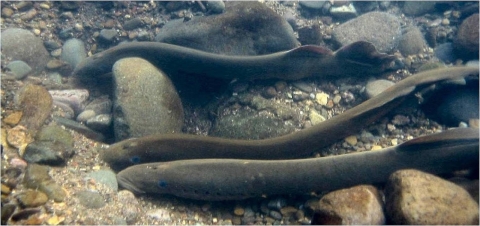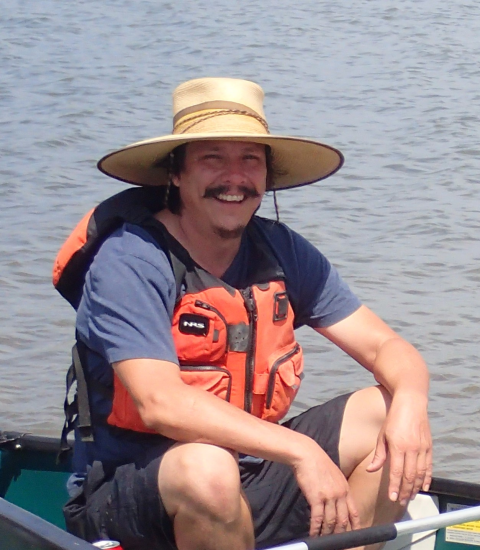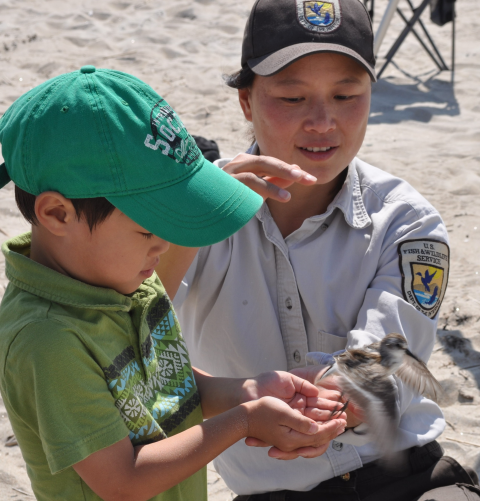U.S. Fish and Wildlife Service employees perform a wide range of jobs, and as Mara Koenig, with our Office of Communications in the Midwest Region, says, “Every employee is involved in endangered species in some form.” Hear from a select few:
Vicki Finn, Conservation Coordinator, Science Applications, Pacific Region
How did you get involved with endangered species conservation?
I have always loved animals and grew up fishing on our family pond, catching fireflies on summer nights, and watching Mutual of Omaha's Wild Kingdom. In college I took an ornithology class from a Dr. Byrd (yes, the name is real), which introduced me to at-risk raptors that were finally rebounding post banning of DDT. And that changed my career trajectory from medicine to wildlife. In 1989, I was fortunate to land a job at Service Headquarters in the Division of Endangered Species at a time when the Service was revamping the recovery program. I was working with amazing visionary leaders like Jamie Clark, Mike Spear, LaVerne Smith, and Gary Frazer. We were focused on innovating and incentivizing the Endangered Species Act not only for listed species but at-risk candidates as well. I moved to the Pacific Region shortly after the Northern spotted owl was listed, which was a very challenging time in the Pacific Northwest. While I have been in other programs since 2001, I have stayed committed to addressing at-risk species needs with the goals of addressing their threats and providing enough conservation, so listing is not needed under the ESA. One of my proudest moments was working in Fish and Aquatic Conservation on Pacific lamprey conservation. Through collaboration with stakeholders, we helped stabilize the species. Today my pride and joy are our work on at-risk pollinators. My hope is our pollinator work in Science Applications can do the same for many of our at-risk pollinators.
What are you most excited for in the future regarding endangered species conservation work?
Our new employees! Their skills, passion, and energy bring me hope. They are starting their careers with amazing technical skill and global awareness of what's at stake not only for our endangered species but for humans as well. With the new cadre of social scientists we are hiring in Science Applications, we are poised to continue to work more effectively with our publics to create more durable conservation solutions. Our future is bright because of our people.
Pete Diaz, Fisheries Biologist, Fish and Aquatic Conservation, Southwest Region
How did you get involved with endangered species conservation?
I started working with the Service in college through one of the entry programs as a paid intern. I learned valuable lessons in biology and got to see how the Service works. I ended up staying with the Service after I got my master's degree.
Why is the work that you do important for future generations?
The work we are doing today has weight as measured by the past. Many places and species are still here because a few biologists working on them cared enough to fight for them and provide data to protect habitat and the overall ecosystem. In Texas, an argument could be made that some of our favorite swimming holes might be dry if it weren’t for the presence and persistence of species listed under the Endangered Species Act.
Mara Koenig, Communications Lead for the Center for Pollinator Conservation, Office of Communications, Midwest Region
How did you get involved with endangered species conservation?
It's part of the foundation of our agency. I believe every employee is involved in endangered species in some form, whether it's habitat restoration, outreach and education, or building and maintaining partnerships.
Why is the work that you do important for future generations?
People will not know, will not care, and will not act to conserve wildlife and plants unless we communicate well and often with them. We need to be a voice, a role model, and to welcome all people to explore, learn, and ask questions about the natural world.
Eric Prowell, Fish and Wildlife Biologist (Transportation Liaison), Ecological Services, Southeast Region
How did you get involved with endangered species conservation?
I was working on my master's degree in hydrology at the University of Georgia when I had the opportunity to intern with the Service - Georgia Ecological Services. That is when I was first introduced to endangered species conservation. My master's research was focused on maintaining natural hydrologic regimes in developing landscapes, and Georgia Ecological Services was charged with the protection and recovery of imperiled aquatic species in developing regions of North Georgia. The opportunity to not only apply my skillset but improve both policy and on-the-ground, actions was too great a match to pass up. I have been with Georgia Ecological Services ever since (20 years).
Why is the work that you do important for future generations?
The progress we have made the last 25 years wouldn't have happened without the hard work and progress of the previous 25 years. That constant incremental progress toward improving what we know and implementing it on the ground is paramount in the progress that will be made in the next 25 years or 50 years. My supervisor and mentor (Dr. Robin Goodloe) would always remind me progress in conservation happens through “baby steps.” Those incremental steps through time are how we move toward what Aldo Leopold described as "harmony" with the natural world and the critters that it supports.
Nancy Pau, Wildlife Biologist, National Wildlife Refuge System, Northeast Region
How did you get involved with endangered species conservation?
I grew up in New York City watching Wild America with Marty Stouffer on PBS. As a high school student, I got an opportunity to do research at Iowa State and Cornell universities during the summer. When I learned that wildlife conservation was a career choice, that was it for me. In the last month of my senior year at Cornell, I was at the right place at the right time, and was recruited by a refuge biologist. Since then, I've worked as an endangered species biologist at the Sacramento Field Office, and now work to recover several endangered species (piping plovers, northern long-eared bats, red knots, and Atlantic sturgeon) as a wildlife biologist at Parker River National Wildlife Refuge.
Why is the work that you do important for future generations?
We have a responsibility to ensure that future generations will be able to enjoy the full diversity of wildlife. This was reinforced for me recently when I met a young family who made a special trip to Parker River from Brooklyn because their 7-year-old wanted to see a peregrine falcon.Similarly, we made a special trip to California a few years back so that my son could see a California condor in real life. The work we do ensures that future kids don't have to learn about these species in a book or Wikipedia but can experience the magic of seeing them in the wild for themselves.
Cassie Powell, Native American Liaison, Office of Communications, Mountain-Prairie Region
How did you get involved with endangered species conservation?
I was born and raised on the Blackfeet Reservation on the family ranch and grew up learning the connection that Native Americans have with the land and animals. I was raised to co-exist with everything present and appreciate what was given from the land and to take nothing for granted as future generations would be dependent on how we took care of the land and animals. I knew at an early age what I wanted as a career, and eventually I graduated with my bachelor’s in fish and wildlife biology. I was one of the first Native American women to graduate on my reservation in this line of work and have since then worked in many positions in the federal and Tribal sectors to gain valuable knowledge furthering my skills.
Why is the work that you do important for future generations?
The work I’m currently doing will be of value for future generations by connecting Tribes and the Service and other entities together to bridge gaps, identify needs and solutions, and build relationships to collaborate to protect mother earth and all that inhabit it.
Jared Laufenberg, Refuge Biometrician, National Wildlife Refuge System, Alaska Region
How did you get involved with endangered species conservation?
The focus of my Ph.D. research beginning in 2008 was to evaluate the recovery status of federally threatened Louisiana black bears in Louisiana. My field research involved working with numerous partners including several national wildlife refuges, multiple state agencies, and many private landowners. Results from that research provided evidence used by the Service in its decision to remove Louisiana black bears from the threatened species list in 2016. My Ph.D. research led directly to a postdoctoral fellowship focusing on developing and evaluating new monitoring strategies for the Louisiana black bear post-delisting monitoring plan.
Why is the work that you do important for future generations?
A key element of the work I do as a biometrician within the National Wildlife Refuge System is to build and share scientific knowledge about how our nation’s natural resources will respond to change. [It’s] knowledge that current and future generations need to make conscientious conservation decisions in ever-changing environments.
Kitti Jensen, Grant Management Specialist, Ecological Services, Pacific Southwest Region
How did you get involved with endangered species conservation?
I spent a lot of time outdoors exploring as I was growing up. In the summers, I would go to my grandparents’ cattle ranch in eastern Oregon. We rode horses, went on cattle roundups, caught frogs, lots of camping and fishing – everything was outdoors. I was obsessed with animals and being outside. Having that outdoor connection was critical in forming my attachment to conservation.
When I started college, my intention was to make documentaries for conservation. I wanted to capture moments in time to educate others and increase public awareness of wildlife and nature. In my sophomore year, I was recruited by the Army Corps of Engineers to work on a large habitat restoration project. I changed my major from film to zoology and began my 38-year conservation career.
Why is the work that you do important for future generations?
Part of our role as FWS biologists is working to recover and delist species. Our recovery plans provide a framework, but we need partners to help implement recovery actions. The FWS provides incentives for conservation partners through financial assistance (grants and cooperative agreements). Working on the FWS’ endangered species grants, such as Cooperative Endangered Species Conservation Fund and Recovery Challenge, has been one of the most rewarding aspects of my career. There is satisfaction when we see a large land acquisition grant close and know those lands are conserved in perpetuity. I have an active role in conserving diverse, healthy ecosystems and open space for future generations to experience and develop their own connection to the outdoors.
Matthew Luizza, Program Officer (Biologist), African Elephant Conservation Fund, International Affairs, Headquarters
How did you get involved with endangered species conservation?
For me, like I imagine for many others in the field of conservation, my interest started at a young age. I’ve had a strong affinity for the outdoors and wildlife for as long as I can remember, and the added good fortune of growing up in the Front Range of Colorado provided ample opportunities to cultivate this passion. If I wasn’t absorbing all I could about charismatic species (especially gray wolves and African elephants), I was outside exploring. I have vivid memories, as an elementary school-aged kid, of very purpose-driven rescue operations to save barred tiger salamanders trapped in our window wells after heavy rains. Although not an “endangered” species, to me, in those moments, they were imminently “in danger,” regardless of whether they truly needed my help or not. Fast forward, and my conservation journey has followed varied streams that have afforded me the chance of working in diverse, shared landscapes that are home to an array of threatened and endangered wildlife and a diversity of communities that are intimately connected to the land and water. This has spanned operating as a wildland firefighter in Colorado, to working as a budding interdisciplinary ecologist, conducting research in Alaska and Ethiopia. All of which fostered a strong appreciation and sustained curiosity for better understanding different ways of knowing a given landscape, spanning conventional science and traditional wisdom. Now, I have the privilege of working with amazing colleagues across the Service and conservation partners on the ground, through management of the African Elephant Conservation Fund, the goal of which is to ensure healthy African elephant populations in the wild, while improving pathways for human-elephant coexistence.
Why is the work that you do important for future generations?
I would first emphasize that it’s the work (the real heavy lifting) of dedicated, trusted conservation partners on the ground that is so critical right now and for future generations. I feel very honored and humbled to be able to play some role in elevating and facilitating their tireless efforts and supporting the capacity development of African conservation champions, through management of the African Elephant Conservation Fund, which provides financial and technical assistance to projects across Africa’s 37 elephant range states. Without this work, we run the risk of losing both species of African elephants (forest and savanna), with forest elephants at especially high risk, being critically endangered, or one step removed from extinction. I have two kids (both under 5), and I don’t want them or anyone else in their generation to grow up in a world without African elephants. Like many other threatened and endangered species, they are essential to the health and resilience of the landscapes they inhabit, as “forest gardeners” and “ecosystem engineers,” and they continue to teach us valuable lessons about ourselves and our humanity – the importance of community and empathy, and how our fates are intertwined. This work increasingly requires more holistic approaches to conservation that empower and amplify co-creation and different ways of knowing, emphasizing our role as stewards and caretakers of the Earth and each other. For many (including myself), the draw of working in the field of conservation is the wildlife (protecting, conserving, and preserving species and their habitats). However, at the end of the day, conservation is about people. Navigating distinct and shared values, managing conflict, building or re-gaining trust, fostering relationships, and forging a path forward, together, with the shared vision of a sustainable future that provides space, security, and dignity for people and wildlife.







